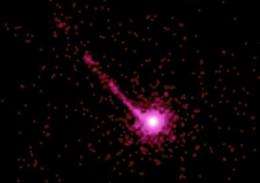March 14, 2013 report
Astrophysicist calls on colleagues to develop better models to explain quasars

(Phys.org) —Robert Antonucci, professor of astrophysics at the University of California, Santa Barbara, suggests in a commentary piece in the journal Nature that he and his colleagues need to develop better models of black-hole systems to help gain more knowledge of quasi-stellar radio sources, known more commonly as quasars. The problem is, he says, after a half century of study, scientists still can't explain how it is that they emit so much energy.
Quasars are highly luminous galactic systems and can be seen from very far away—one was first distance measured only as recently as 50 years ago (it's anniversary coming March 16 likely inspired Antonucci to provide his commentary piece). And while space scientists generally agree that a quasar is likely a region of space with many elements compacted together, all surrounding a supermassive black hole, not much else is really known about them. Antonucci says that despite all the research that's been done on them, there are still no good models to describe how they manage to produce so much energy and thus there is no way to predict their behavior. He goes so far as to suggest in comical fashion that the state of science regarding quasars is so limited that researchers should begin hoping an extraterrestrial being will drop by one day to explain it all.
In a more serious vein, Antonucci suggests that it's not an impossible challenge to learn more about quasars, but it will take some effort, and that is the purpose of his article—to push for more research—such as developing stronger computational and computer models and to use new tools such as more sensitive X-ray telescopes to study quasars in better detail.
Because they can be seen from so far away, quasars offer researchers a unique opportunity to peek farther back in time than is offered by other celestial bodies. For that reason, it's important that they be better understood, Antonucci says. Current theories suggest that because they expel jets of energetic particles and emit at radio wavelengths, and because the energy involved is so great, there must be a supermassive black hole at their center. But the details of how it all works is still a mystery and because of that, he says, researchers need to step up their efforts.
More information: Astrophysics: Quasars still defy explanation, Nature 495, 165–167 (14 March 2013) doi:10.1038/495165a
Abstract
Fifty years after finding that these cosmic beacons lie far away, astronomers need to think harder about how they radiate so much energy, says Robert Antonucci.
Journal information: Nature
© 2013 Phys.org


















